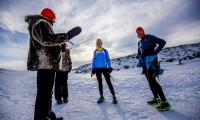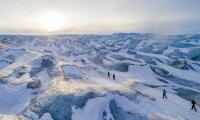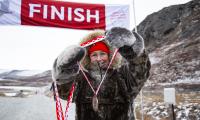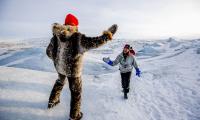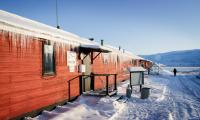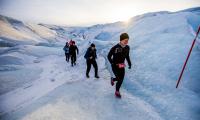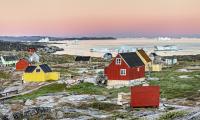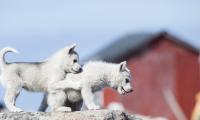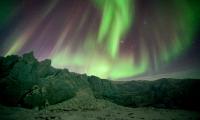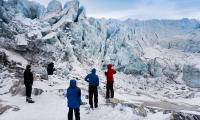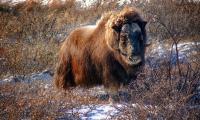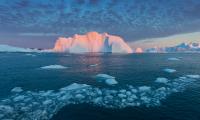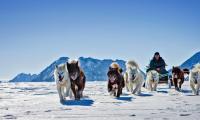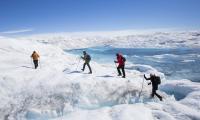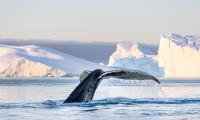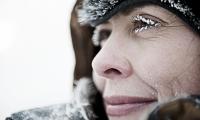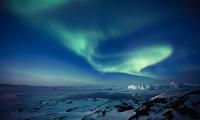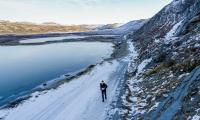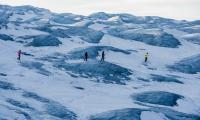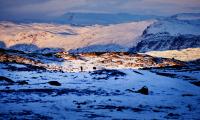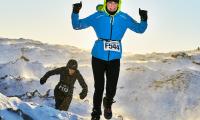Travel to Greenland
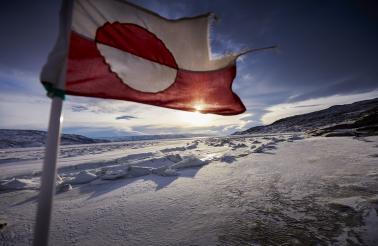 Greenland is like nowhere else in the world. In the winter, popular activities include dog sledding, ice fishing, and gazing speechless at the Northern Lights. In the summer, when the sun shines 24/7, one can walk across glaciers, kayak through the Icefjord, or watch for whales out at sea. In either season, you can expect to encounter friendly Greenlanders, an abundance of colorful houses, and lots of cozy coffee time.
Greenland is like nowhere else in the world. In the winter, popular activities include dog sledding, ice fishing, and gazing speechless at the Northern Lights. In the summer, when the sun shines 24/7, one can walk across glaciers, kayak through the Icefjord, or watch for whales out at sea. In either season, you can expect to encounter friendly Greenlanders, an abundance of colorful houses, and lots of cozy coffee time.
The Location
Disco Bay
West Greenland is Greenland's most populous region. Approximately half of Greenland's 56.000 inhabitants live here in bigger towns along the caost. Four such towns are located in the largest bay in Greenland: Disco Bay. Here, massive icebergs linger in the freezing waters. These icebergs come from the famous Icefjord, where they are born by the enormous Sermeq Kujalleq Glacier. This 10-km wide glacier is the most productive glacier outside of Antarctica. While most glaciers calve at a rate of around 1 meter (3 ft) per day, the Sermeq Kujalleq Glacer calves at a rate of 25 meters (82ft) per day - this equates to calving approximately 46 cubic kilometers of ice every year. If that amount of ice was melted, it would cover the drinking water needs of the entire United States!
In addition to the Icefjord, Disco Bay offers excellent whale watching year-round, with various species that are either native to the area or migrate in the summer from the Caribbean Sea. The region is also well-known for being a dog sled district - in fact, Disco Bay is the only place in West Greenland that offers summer dog sledding (on Lyngmark Glacier). Finally, Disco Bay contains several islands where pristine nature, local culture, and adventures abound.
Ilulissat
In the middle of Disco Bay lies the town of Ilulissat, formerly known as Jakobshavn. Ilulissat is Greenland’s third-largest town with a population less than 5.000, and, despite its location 300 km north of the Arctic Circle, it is in every way a lively, hospitable, and colorful city.
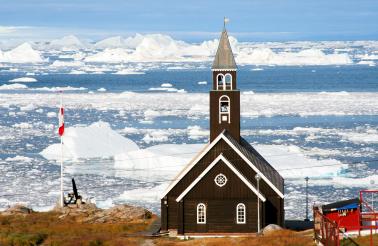
Rightly nicknamed the “Iceberg Capital,” Ilulissat is located just north of the Icefjord. Using Ilulissat as a base, the gigantic icebergs in the Icefjord can be experienced via land, water, or air. The importance of the Sermeq Kujalleq glacier to glacial science, combined with the unique natural beauty, has secured the Icefjord a spot on UNESCO’s World Heritage List. This was the first place in Greenland to be recognized by UNESCO, and, upon visiting, you will quickly understand why. In the summer, one can look forward to seeing Disco Bay’s mighty icebergs basking in the glow of the midnight sun. The icebergs are visible from nearly everywhere in town, or you can opt to walk 2 km down a wooden footpath to reach the Icefjord. Along the way, you pass the ruins of Sermermiut, an ancient Inuit settlement. Alternatively, you can join a tour via kayak, boat, stand-up paddleboard, or helicopter to get an up-close-and-personal view of the icebergs.
Those that visit the city in the winter are likely get a view of a fantastic phenomenon: a glimpse of the world’s largest cinema, where the dancing northern lights play the lead role. People also flock to experience the sled culture, as well as the renowned Greenlandic hospitality.
During the more than 250 years that have passed since the town was established, it has steadily flourished. Today, it is vibrant and welcoming, with a wide range of cultural attractions and great adventures awaiting at sea or in the backcountry.
Kangerlussuaq
Perhaps one of the most recognizable names in Greenland, Kangerlussuaq lies south of Disco Bay and is the location of the country’s international airport. Formerly known as Søndre Strømfjord, the present-day town was founded as a U.S. Air Force base during World War II. Since then, it has developed into a welcoming town for visitors and residents.
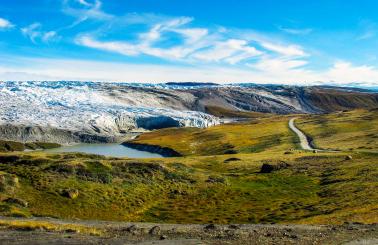 Kangerlussuaq is located on a plain overlooking the 170-km long “Big Fjord.” Its location is sheltered by the ice cap and the surrounding mountains, contributing to relatively stable weather conditions. This means that Kangerlussuaq has approximately 300 clear nights a year, and it is consequently one of the best places in Greenland to watch the renowned Northern Lights.
Kangerlussuaq is located on a plain overlooking the 170-km long “Big Fjord.” Its location is sheltered by the ice cap and the surrounding mountains, contributing to relatively stable weather conditions. This means that Kangerlussuaq has approximately 300 clear nights a year, and it is consequently one of the best places in Greenland to watch the renowned Northern Lights.
Additionally, Kangerlussuaq is the only place in Greenland where it is possible to literally drive onto the ice sheet. Any other location requires you to hike, sail, or fly, but here, a 25-km dirt road out of town offers easy access to the ice cap. The opportunities to explore nature outside the town are limitless. From hiking trails along the fjord to thrilling walks across glaciers, there’s something for everyone to enjoy.
History and Culture
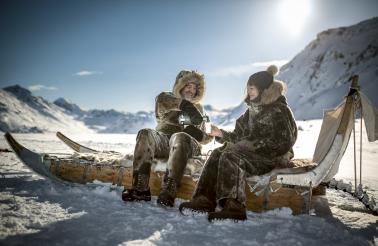 History: An icy story of Inuits and Vikings
History: An icy story of Inuits and Vikings
The first people to set foot in Greenland were groups of Paleo-Eskimos. They arrived in Greenland around 2400 BC and disappeared in 1000 BC. Their culture became known as Independence I in recognition of Independence Fjord in northern Greenland, where a Danish archeologist first discovered their remains in the mid-1900s.
It took almost another 2000 years before the ancestors of the current native Inuit population arrived. The Thule people came to Greenland around 1000 AD, bringing with them technical knowledge and the skills to build useful equipment such as the dog sled and the qajaq – the Greenlandic sea kayak.
The final Inuit immigration occurred around the same time as the arrival of Norse Vikings and Erik the Red, who bestowed the name ‘Greenland.’ The Norse vanished from Greenland for around 800 years, but made a resurgence in 1721 with an evangelical mission. This resulted in most Greenlanders converting to Evangelical Lutheranism. Greenland formally came under Danish rule in 1729.
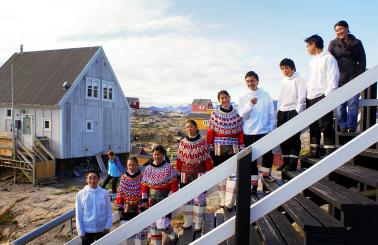 Indigenous Population
Indigenous Population
Danish governance led to an influx of Danish citizens to Greenland. However, indigenous people still account for nearly 90% of Greenland’s population. The overarching term for Greenland’s indigenous peoples is “Inuit.” Descended from the Thule people, the Greenlandic Inuit are ethnographically composed of three primary groups: the Kalaallit, the Tunumiit, and the Inughuit. The Kalaallit are the largest proportion, and historically refers to the people from West Greenland. Hence, they speak Kalaallisut, and refer to Greenland itself as “Kalaallit Nunaat,” which means “the land of the people.”
Government
Greenland remained a colony of the Kingdom of Denmark until 1953, when Denmark amended the Danish Constitution naming Greenland as an integral constituency in the Danish Kingdom. Following a voter referendum in 1979, the Danish parliament granted Home Rule to Greenland, thereby allowing Greenland to establish its own parliament, which has 31 members today.
In a 2008 referendum, Greenland voted yes to pursue autonomy from Denmark. Among other things, this means that Greenland is able have its own stance on foreign policy issues. Greenland is now moving towards full independence, however, they still receive an annual subsidy from Denmark of 3.5 billion Danish Kroner (approx. $588 million).
Language
The official language in Greenland is Greenlandic, with the primary dialect being Kalaallisut (West Greenlandic). Since 2009, Greenlandic has been the sole official language. However, Danish is still widely used, and most of the Inuit population speaks Danish as a second language. English is limited but becoming more popular, particularly among young Greenlanders.
Dog Sledding
Greenlandic sled dogs form an integral part of Inuit culture. For approximately 5000 years, dog sledding has served as a means for transportation and hunting. Techniques for dog mushing have passed down through the generations, and children are often given a small sled and a few dogs of their own so they can start learning young. However, the sled dog should never be mistaken for a pet – it is a working animal and must be respected as such.
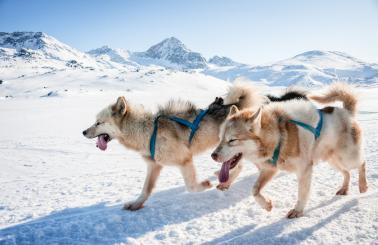 The Greenlandic sled dog is its own race whose purity is strictly protected through crossbreeding regulations. Please note that it is common to see a dog being punished by the mushers if it is not obeying or being aggressive toward other dogs – this is completely normal, and necessary to maintain the respect between the dogs and the mushers.
The Greenlandic sled dog is its own race whose purity is strictly protected through crossbreeding regulations. Please note that it is common to see a dog being punished by the mushers if it is not obeying or being aggressive toward other dogs – this is completely normal, and necessary to maintain the respect between the dogs and the mushers.
In the winter, visitors can experience the magic of dog sledding for themselves. Gliding over the soft white snow as you feel the frigid arctic breeze on your face and listen to the rhythmic padding of the paws is an experience to be remember. In the summer, guests can still meet the dogs and mushers and hear about the fascinating cultural history.
Modern Greenland
Greenland today is a fascinating mix of the past and the present. In some respects, the modernization is clear – snowmobiles race alongside dog sleds, and cell phones have become commonplace. Nevertheless, Greenland has managed to maintain its traditional feel. This is evident in its food, its crafts, and its festivals. The traditional way of life is still honored and practiced, and the myths and sagas are passed down among generations.
Cuisine
Greenlandic food has traditionally incorporated large amounts of meat, and this holds true today. Hunting and fishing are an integral part of Greenlandic culture, and the sea is the primary source for most food. Visitors can try traditional sources of nourishment such as seal, whale, or seabird. Seafood fare can also include various fish, mussels, and shrimp. Partaking in a shared meal is an important aspect of Greenlanders’ society, and visitors can expect to be warmly welcomed to meals that include both traditional Greenlandic food and international dishes.
Geography and Geology
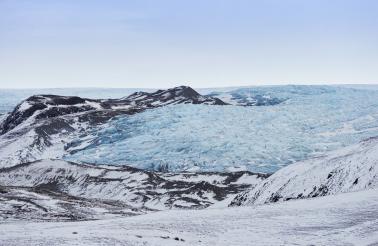 Greenland is renowned for its distinct geography. Covering 2.184.700 km2 (843,517 mi2), it is the largest island in the world. Two-thirds of the island are north of the Arctic Circle and nearly 81% is covered by ice. This ice is part of the Greenland Ice Sheet, which is second in size only to the Antarctic Ice Sheet.
Greenland is renowned for its distinct geography. Covering 2.184.700 km2 (843,517 mi2), it is the largest island in the world. Two-thirds of the island are north of the Arctic Circle and nearly 81% is covered by ice. This ice is part of the Greenland Ice Sheet, which is second in size only to the Antarctic Ice Sheet.
On the outer boundary of the ice sheet, there are ‘outlet glaciers.’ These are restricted tongues of the ice sheet that make contact with the ocean on the edges of the island, calving off large chunks that produce the numerous icebergs floating around the island. This results in a constantly changing landscape along the coasts – the views are never the same from year to year!
Russell Glacier
Only 25 kilometers outside of Kangerlussuaq, located in the UNESCO World Heritage Site of Aasivissuit-Nipisat, towers the magnificent Russell Glacier. The glacier stands like a soldier guarding the inland ice sheet – an impressive wall of ice that reaches up to 60 meters (197 ft) at some points. The glacier is active, and advances around 25m (82ft) per year. Up on the glacier, it offers breathtaking views of the famous Greenland Ice Sheet and the magnificent meltwater outflows. Additionally, Russell Glacier is referred to as Reindeer Glacier by the locals, and the drive up to it offers an excellent chance to see some wildlife.
Midnight Sun and Northern Lights
The midnight sun occurs everywhere that is north of the Arctic Circle, including Ilulissat, and is visible from roughly mid-June to the end of July, depending on location. The midnight sun describes a phenomenon where the sun is in plain view at midnight local time. Of course, nights are still bright in the weeks before and after the midnight sun is visible. South of the Arctic Circle nights are also light in these months, but the midnight sun itself only makes an appearance in the north.
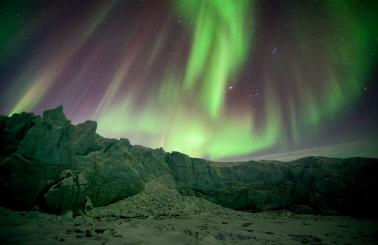 The Northern Lights are another unique polar experience. They occur year-round, but, naturally, they can only be experienced in the months where there are dark hours. The ethereal light display is the result of a scientific phenomenon where gaseous protons and electrons from solar wind collide with molecules in Earth’s atmosphere. The color variations are due to the type of gas particles that collide and the altitude at which the collision takes place. Oxygen molecules at lower altitudes of up to 241 km (150 mi) produce the most common color, a yellowy green; then deepen to shades of red above 241 km (150 mi) high. Nitrogen produces blue hues at altitudes up to 96.5 km (60 miles); and vivid purples above 96.5 km (60 miles).
The Northern Lights are another unique polar experience. They occur year-round, but, naturally, they can only be experienced in the months where there are dark hours. The ethereal light display is the result of a scientific phenomenon where gaseous protons and electrons from solar wind collide with molecules in Earth’s atmosphere. The color variations are due to the type of gas particles that collide and the altitude at which the collision takes place. Oxygen molecules at lower altitudes of up to 241 km (150 mi) produce the most common color, a yellowy green; then deepen to shades of red above 241 km (150 mi) high. Nitrogen produces blue hues at altitudes up to 96.5 km (60 miles); and vivid purples above 96.5 km (60 miles).
It’s such a beautiful and captivating sight that even residents of Greenland never grow tired of the display, but instead can be seen gazing skyward in wonder. The Northern Lights hold a special place in Greenlandic culture, as the phenomena is linked to time-honored stories and superstitions that are still passed from generation to generation.
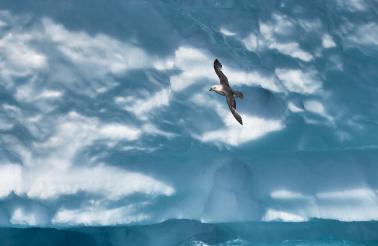 Flora and Fauna
Flora and Fauna
The vegetation in the Ilulissat area is classified as mid-Arctic tundra. This means that plant life is largely characterized by stunted bushes and mossy grasses, which rarely grow beyond 50 cm in height. However, there are hundreds of different species of lichen and flowering plants, contributing to a dreamy, vast landscape.
Wildlife is abundant in the region, and there is good chance that during your visit you can glimpse whales, seals, and caribou. Several species of whale inhabit the region, including humpback whales, orcas, and narwhals. Polar bears and foxes also live around the bay, but it is rare to spot them. Finally, there is an abundance of fish and crustaceans, which results in a rich birdlife.

